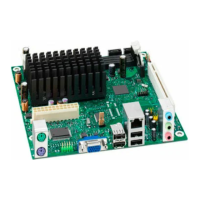
Do you have a question about the Intel D410PT and is the answer not in the manual?
| Brand | Intel |
|---|---|
| Model | D410PT |
| Category | Motherboard |
| Language | English |
Describes the Intel Atom processor, its cooling, and integrated features.
Explains DDR2 SDRAM support, capacity limits, and configurations for the motherboard.
Covers the Intel NM10 Express Chipset's role in I/O interfaces and system control.
Details the USB 2.0 ports, their arrangement, and compliance requirements.
Explains the SATA interface connectors, transfer rates, and configuration modes.
Outlines power management implementation, ACPI support, and hardware features.
Explains ACPI's role in OS control of power management and Plug and Play functions.
Details the supported system and power states and their targeted system power.
Lists devices and events that can wake the computer from various ACPI states.
Describes the board's various connectors and headers, categorized by location.
Details the 2x12 power connector and power supply requirements for the board.
Explains the functions and pin assignments of the front panel header.
Provides a connection diagram and notes for the front panel USB headers.
Locates and explains the BIOS configuration jumper block and its modes.
Addresses critical thermal requirements, chassis airflow, and component temperature limits.
Presents power measurements for minimum and maximum load configurations.
Details the power draw and consumption for a bare system configuration.
Shows power requirements for a fully-featured system under maximum load.
Describes how legacy USB support enables USB devices before OS drivers load.
Covers user choices for boot devices like CD-ROM, network, and sequential priority.
Details BIOS security features like supervisor and user passwords for access control.
Lists BIOS beep codes generated by the speaker to indicate recoverable errors during POST.
Describes blink patterns of the front panel power LED as error indicators during POST.
Lists BIOS error messages displayed during POST and their explanations.
Explains POST codes generated to I/O port 80h for diagnosing POST failures.
